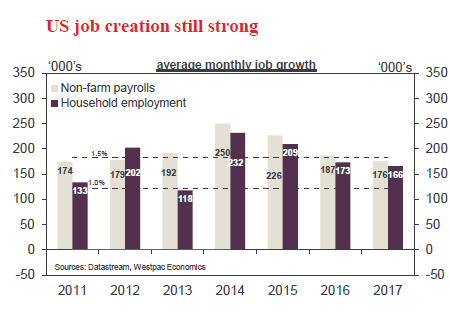Week beginning 2 October 2017
- RBA on hold in October: to repeat growth overview from last month.
- Australia: CoreLogic home value index, dwelling approvals, retail sales, trade balance.
- NZ: survey of business opinion.
- China: foreign reserves, FDI.
- Euro Area: ECB minutes, unemployment.
- US: Fed Chair Yellen speaks, nonfarm payrolls.
- Key economic & financial forecasts.
Information contained in this report was current as at 29 September 2017
RBA on hold in October: to repeat growth overview from last month
The Reserve Bank Board meets next week on October 3.
There will be no change to the cash rate. As with recent meetings, the interest will be in the Governor’s commentary.
In fact, we don’t envisage too much change in the key themes:
- "conditions in the global economy are continuing toimprove".
- "growth in the (Australian) economy will gradually pick upover the coming year".
- "the outlook for non-mining investment has improved".
- "residential construction remains at a high level, but littlefurther growth is expected."
- "slow growth in real wages and high levels of household debtare likely to constrain future growth in spending".
- "the unemployment rate is expected to decline a little overthe next couple of years".
- "stronger conditions in the labour market should see somelift in wages over time".
- "an appreciating exchange rate would be expected to resultin a slower pick-up in economic activity and inflation thancurrently forecast".
- "there are signs that conditions (housing) are easing,especially in Sydney".
- "growth in housing debt has been outpacing the slow growthin household incomes".
- "the Board judged that holding the stance of monetarypolicy unchanged… would be consistent with sustainablegrowth in the economy and achieving the inflation targetover time".
These assessments are consistent with a neutral policy bias.
Markets and many banks expect this bias to change by year’s end to a tightening bias.
We expect the cash rate will remain on hold over the course of 2017, 2018 and 2019. We point out that the RBA has a very different growth outlook for the Australian economy and Australia’s trading partners than our own. The RBA expects growth in Australia to be 3.25% in 2018 and 3.5% in 2019 (above trend of 2.75%). Westpac expects a below trend pace of 2.5% in both years.
The RBA is also forecasting 2% underlying inflation in 2017 and 2018 (bottom of target band) to be followed by 2.5% in 2019. Underlying inflation is currently running at 1.8% (to June) and the upcoming revised weights (to be applied from the December quarter) are likely to reduce annual underlying inflation by 0.2- 0.3% over the course of 2018. Once these weights are released the Bank might have to reconsider its base case (1.5%-2.5%) for 2018.
While the RBA does not provide detailed forecasts outside growth and inflation, the RBA Governor’s likely comments, as set out above, point to a more confident outlook for wages growth; employment; non-mining investment and the residential construction cycle than we are seeing.
A major puzzle for central banks globally has been the limited response of wages to stimulatory monetary policies since the GFC.
Despite these policies in the US; Germany; the UK and Japan driving labour markets to near or full employment, wages have failed to respond. Explanations for this phenomenon have been structural: globalisation; technology; retiring higher paid baby boomers; low productivity growth; an absence of pricing power for employers; low inflation and wage expectations; high risk aversion following the GFC and job insecurity in the face of technology threats.
Consistent with that global theme, wages growth in Australia has also been weak. Australia’s wage price index has increased by 1.9% over the last year compared to average growth of 3.5%. The unemployment rate has held in the 5.5%-6.0% range compared to a generally accepted full employment rate in Australia of 5%. Australia had also been raising wages at a faster pace over the last 20 years than other developed countries, exacerbating our lack of competitiveness and further containing our wage growth prospects.
This weak wages performance has lowered annual real income growth to 0.6% while real consumption growth has held around 2.5%. Households will need to protect their fragile savings rate and pressures will emerge on consumer spending. The Reserve Bank seems to recognise this effect, but by assuming faster jobs and wages growth, they are likely to be factoring in faster income growth than we are expecting. Other pressures are impacting households – rising energy prices; record high debt levels and political uncertainty. The latter effect will work through the business sector as businesses restrain employment and investment until political clarity is achieved following the 2019 election. It seems likely that the Bank has a much more optimistic outlook for non-mining investment than we are expecting.
Markets and the RBA may be underestimating the impact on the interest rate sensitive housing market of developments which are unfolding without official rate hikes.
The four majors (90% of the mortgage market) have been raising investor and interest only mortgage rates while applying tighter lending guidelines. House price inflation is slowing and regulators are unlikely to have any patience with a reversal of this trend. We expect that if we did see reversals, the RBA is more likely to embrace a further round of macro-prudential tightening than embark on a new tightening cycle.
To that point, six month annualised house price inflation (CoreLogic data) in Sydney has slowed from 22.4% in January to 4.8% in August. We observed a similar response to macroprudential policies in 2015/16 when six month annualised house price inflation slowed from 25% (July 2015) to -4.4% (April 2016), although rate cuts in 2016 reversed that trend.
Housing activity is also slowing despite a steady cash rate. Other factors, specifically relating to foreign investors, have turned the cycle. High rise building approvals have tumbled by 40% in the last year. This has been particularly due to investment restrictions in China; lending constraints by banks; and sharp increases in state government stamp duties for foreign investors. This downturn is likely to continue for at least a further two years as foreign developers unwind commitments and local developers await more affordable development sites.
While markets are currently captivated by expectations of a coordinated lift in global growth, we are more circumspect with respect to Australia’s trading partners. After tightening his grip on power next month, China’s leader, Chairman Xi, will focus on risks associated with the credit excesses since the GFC. Tighter credit conditions will slow China’s growth rate – we forecast a growth slowdown from 6.7% in 2017 to 6.2% in 2018.
Bill Evans, Chief Economist
New Zealand: Week ahead & Data Wrap
Behind closed doors
Post-election negotiations between the major political parties mean that the form of the next Government – and hence the mix of economic policy – won’t be known to the public for another couple of weeks. Meanwhile, the Reserve Bank largely stuck to its lines in this week’s OCR review, but hinted at a more substantial change to its forecasts in the November Monetary Policy Statement.
As expected, New Zealand’s general election delivered no clear outcome. Neither the incumbent centre-right National Party, nor the centre-left bloc of the Labour and Green Parties, has the numbers to form a government. This leaves the centrist and nationalist NZ First Party in a monarch-maker position.
NZ First leader Winston Peters has said that he won’t be making any decisions before 7 October, when the special vote count is expected to be announced. Special votes include late enrolments and people voting outside their electorates (including university students). These votes tend to skew left; in the last few elections, National have lost a seat and the Greens have gained a seat once the special votes are incorporated. The high number of special votes this time (about 15% of the total) means that National may even lose a second seat to Labour or the Greens. Such an outcome would not change the balance of power, but it might make a Labour/Green/NZ First agreement less vulnerable, as it would give them more than the oneseat majority that the current voting results suggest.
With negotiations going on behind closed doors, we won’t have confirmation of the form of the next Government for another couple of weeks at least. For the record, we view a National/NZ First deal as the more likely outcome, in part because a two-way combination is likely to prove more workable than a three-way one.
A National/NZ First government would have fewer implications for our economic forecasts, but we can already identify a few policy areas where changes are likely to be on the table:
Immigration: A key NZ First policy platform is to tighten immigration restrictions – Peters has stated he would prefer net immigration of 10,000 per annum, compared to over 70,000 per annum presently. Net immigration has already started to fall, and we are already forecasting that it will drop to 20,000 by the end of 2020. If some policy change prompted us to forecast a steeper decline in net immigration, we would also consider reducing our GDP growth forecast.
House prices: We suspect that the housing market would initially react positively to a National/NZ First Government – that is, turnover would pick up and prices would be higher than otherwise. It’s true that tighter limits on immigration would reduce expected future demand for housing. But we think that this effect would be outweighed by a ‘relief rally’, given the potential impact on house prices that Labour’s proposed tax changes might have had.
Beyond the near term, though, financial factors such as interest rates and macroprudential lending restrictions will once again hold sway over house prices. There have been some small reductions in mortgage rates in recent weeks as bank funding conditions have improved. But without a more substantial fall in mortgage rates, we think the housing market will turn subdued again over the course of next year.
Monetary policy: NZ First favours changing the Reserve Bank Act with an eye to generating a more exporter-friendly exchange rate. National favours the status quo of inflation targeting, and is unlikely to give any ground on that. However, NZ First’s presence in government does make some sort of change at the Reserve Bank more likely – for example, a change from the present single-decision maker structure to a committee for monetary policy decisions.
Fiscal policy: NZ First’s policies are expensive, and it has not signed up to any budget responsibility agreement. In the first instance we would expect that policy concessions to NZ First, such as its various regional development priorities, could be managed within the Government’s existing budget. However, the direction of risk on fiscal policy is that this Government will hew towards smaller surpluses and more debt than otherwise.
It’s unclear what impact this policy mix would have on inflation pressures and the Official Cash Rate. However, longer-term interest rates may rise slightly if projections for fiscal surpluses are lowered and for public debt are raised.
Turning to the Reserve Bank itself, this week’s OCR Review was much as we expected. The OCR was left unchanged at 1.75%, and the press release retained much of the language of previous statements, including the bottom line: "Monetary policy will remain accommodative for a considerable period. Numerous uncertainties remain and policy may need to adjust accordingly."
However, there were some notable changes in the details, the most important being a downgrade to the RBNZ’s growth outlook. The RBNZ said that "growth is projected to maintain its current pace going forward." This is clearly weaker than the RBNZ’s previous statement that "growth is expected to improve going forward." Construction activity has been weaker than expected in recent quarters, something that has also prompted us to revise down our GDP growth forecasts. The RBNZ also no longer describes population growth as "strong", which may be a veiled acknowledgement of the recent slowdown in net migration.
These comments suggest that the economic forecasts published in the November MPS could be meaningfully different from those in the August MPS. If the most recent quarterly GDP outturn were repeated each quarter, the annual percentage change in GDP would reach 3.2% by June 2018. That compares to the RBNZ’s forecast of 3.8% growth in August. Slower growth implies a slower return to potential output, less inflation pressure, and a lower interest rate path than otherwise.
Weaker growth could be offset to some degree by a lower exchange rate, which has been lower than was assumed in the August MPS. If the decline in the currency persists, the RBNZ would be able to leave its OCR guidance unchanged. But if the exchange rate fails to fall by enough, the RBNZ may have to downgrade its OCR outlook.
Data previews
Aus Sep CoreLogic home value index
Oct 3, Last: 0.1%, WBC f/c: 0.2%
- The overhauled CoreLogic measures provide a much morereliable guide to price changes. Whereas previously it wouldtake 3-6mths and/or multiple measures to confirm a marketshift, the new series appear to give clear signals on a monthto month basis. As such, and with the CoreLogic estimatesalready provided much earlier than other measures, we willnow be treating these as the ‘benchmark’ for Australianhouse prices and reporting/previewing on a more regularbasis.
- The index showed a 0.1% gain in Aug, the 3mth annualisedpace slowing abruptly to just 2.5% from 10.2% in May.The daily index points to a similarly subdued 0.2% gain inSep. Note that Aug and Sep are seasonal highs for pricessuggesting ‘underlying’ moves are likely small negatives.
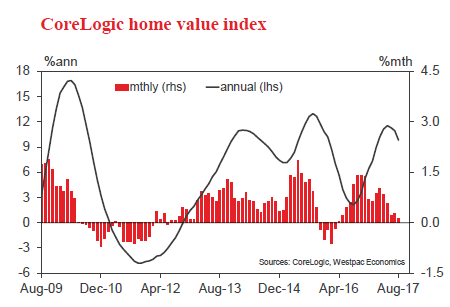
Aus Aug dwelling approvals
Oct 3, Last: -1.7%, WBC f/c: 2.0%
Mkt f/c: 1.0%, Range: -3.0% to 3.0%
- Dwelling approvals dipped 1.7% in July, but were coming offan 11.7% jump in June. Approvals are still down 13.9% vs theirhigh a year ago but over recent months have shown signsof stabilisation for high rise and firming across non high risesegments.
- Construction-related housing finance approvals suggestthe lift in non high rise activity gathered steam through themiddle of the year, annual growth lifting above 10%. Whilewe expect high rise approvals to take another leg lower, astrong lift in the considerably bigger non high rise segmentis expected to dominate in the Aug month, producing a 2%rise in approvals overall. Potentially large offsetting movesmake the estimate more uncertain than usual.

Aus RBA policy announcement
Oct 3, Last: 1.50%, WBC f/c: 1.50%
Mkt f/c: 1.50%, Range: 1.50% to 1.50%
- The RBA is certain to leave rates unchanged again atits October meeting. The Bank has left the cash rateunchanged since August last year.
- Over the past year, economic growth has been patchy(albeit with a lift in momentum recently), annual coreinflation is below the target band, there is still significantslack in the labour market, notwithstanding the recent jobssurge, and wages growth is at historic lows.
- With a number of these trends likely to persist, we expectrates to remain on hold throughout 2017 and 2018. However,market pricing is for two rate hikes in 2018.
- The 2018 outlook is critical to the rates debate. The RBA’scentral case forecast is for growth to accelerate to beabove trend in 2018 and into 2019. We are less convinced,expecting growth to slow to below trend in 2018. See page2 for a more detailed discussion.
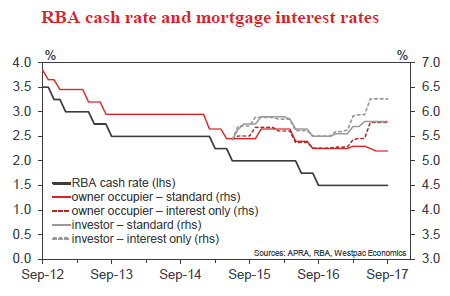
Aus Aug retail trade
Oct 5, Last: flat, WBC f/c: 0.2%
Mkt f/c: 0.3%, Range: -0.3% to 0.6%
- The August retail report shapes up as a particularlyimportant one for gauging the consumer. Retail sales havestalled through June-July suggesting the Q2 reboundfrom a weather affected Q1 has faded quickly and that’underlying’ conditions remain weak. The August update willgive a clearer indication of just how weak.
- Consumer sentiment remained soft in August with financesagain under pressure and consumer caution elevated. Whilethe labour market has seen solid job gains, weak wagesgrowth and structural shifts are seeing a muted impacton incomes. Business surveys also point to weaker retailconditions through July-August although spending on ‘nonretail’ consumer services still appears to be buoyant. Overallthat suggests a disappointing gain. We expect retail sales tobe up just 0.2% in the month.
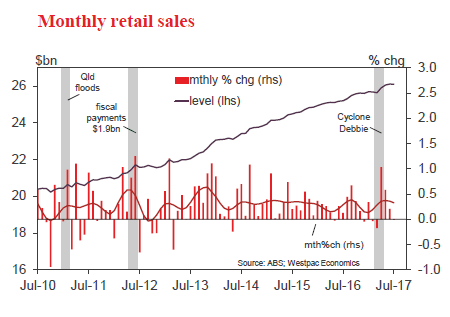
Aus Aug trade balance, AUDbn
Oct 5, Last: 0.46, WBC f/c: 0.5
Mkt f/c: 0.9, Range: 0.1 to 1.5
- Australia’s trade balance has been in surplus in eight of thepast nine months.
- For August, we expect the trade surplus to remainunchanged at $0.5bn.
- Export earnings are expected to be little changed, -0.2%,reflecting the balance of countervailing forces. The mainplus, the iron ore spot price rose to US$76/t, up from $67.Against that are lower volumes for coal and LNG, as well asa sharp pull-back in rural commodity prices.
- The import bill declines by an anticipated 0.3%, as pricesfall in association with the stronger currency. The Australiandollar made further gains in the month, increasing by 1.6%to 79US¢ and up 0.6% on a TWI weighted basis.

NZ Q3 Survey of Business Opinion
Oct 3, General Business Situation – last: +17.8
- Through the first half of the year, the Quarterly Survey ofBusiness Opinion pointed towards firmness in economicactivity. However, confidence has taken a bit of a knockrecently, with uncertainty around the general electionclouding the outlook. We expect that this will put adampener on the September confidence report, surveyingfor which was conducted in the run up to the election.
- Looking through election related volatility, we’ll be keepinga close eye on a number of the survey’s key activitygauges. In particular, we’ll be watching how activity in theconstruction sector is shaping up, and any headwinds theindustry is highlighting. This sector has been a key driver ofgrowth in recent years. However, we’re now seeing growingsigns that momentum in the construction activity is fading.
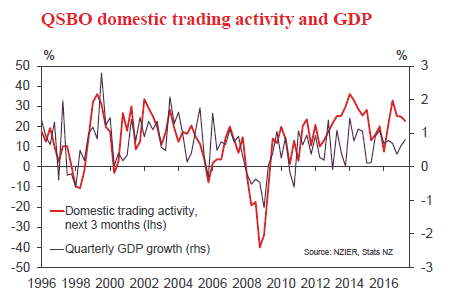
US Sep employment report
Oct 6, nonfarm payrolls, last 156k, WBC 100k
Oct 6, unemployment rate, last 4.4%, WBC 4.4%
- August nonfarm payrolls surprised to the downside, withonly 156k new jobs created in the month and a cumulative41k in downward revisions to June and July. The BLSreported that Hurricane Harvey had no discernable impacton employment in the month.
- September is likely to be a different story, with manyworkers in affected areas forced to stay away. However,continued robust job growth across the rest of the nationshould beget a moderate positive outcome overall. Notethat weather-affected prints can be subject to materialrevisions. Hence it is best to focus on 3 and 6 monthaverages, both of which continue to show strength.
- Household employment is less affected by the weather, soexpect the unemployment rate to remain unchanged at 4.4%.
